clutch HONDA CIVIC HYBRID 2005 7.G Owners Manual
[x] Cancel search | Manufacturer: HONDA, Model Year: 2005, Model line: CIVIC HYBRID, Model: HONDA CIVIC HYBRID 2005 7.GPages: 228, PDF Size: 3.15 MB
Page 111 of 228

You can increase the set cruising
speed in any of these ways:Press and hold the RESUME/
accel button. When you reach the
desired cruising speed, release the
button.
Push on the accelerator pedal.
Accelerate to the desired cruising
speed, and press the SET/decel
button. You can decrease the set cruising
speed in any of these ways:
Press and hold the SET/decel
button. Release the button when
you reach the desired speed.
To increase the speed in very
small amounts, tap the RESUME/
accel button. Each time you do
this, your vehicle speeds up about
1 mph (1.6 km/h). To slow down in very small
amounts, tap the SET/decel
button. Each time you do this,
your vehicle will slow down about
1 mph (1.6 km/h).
Cruise control may not hold the set
speed when you are going up and
down hills. If your speed increases
going down a hill, use the brakes to
slow down. This will cancel cruise
control. To resume the set speed,
press the RESUME/accel button.
The indicator on the instrument
panel will come back on.
When climbing a steep hill, the
automatic transmission may
downshif t to hold the set speed.
Tap the brake or clutch pedal
lightly with your f oot. The
CRUISE CONTROL indicator on
the instrument panel goes out.
When the vehicle slows to the
desired speed, press the SET/
decel button.
CONT INUED
Changing the Set Speed
Cruise Control
Features
109
Page 112 of 228

Even with the cruise control turned
on, you can still use the accelerator
pedal to speed up f or passing. Af ter
completing the pass, take your foot
of f the accelerator pedal. The vehicle
will return to the set cruising speed.
Resting your f oot on the brake or
clutch pedal causes the cruise
control to cancel.Youcancancelthecruisecontrolin
any of these ways:
Tap the brake or clutch pedal.
Push the CANCEL button on the
steering wheel.
Push the Cruise Control Master
Button. When you push the CANCEL button,
or tap the brake or clutch pedal, the
system will remember the previously
set cruising speed. To return to that
speed, accelerate to above 25 mph
(40 km/h) and then press and
release the RESUME/accel button.
The CRUISE CONTROL indicator
comes on. The vehicle will accelerate
to the same cruising speed as before.
Pressing the Cruise Control Master
Button turns the system off and
erases the previous cruising speed.
Cancelling the Cruise Control Resuming the Set Speed
Cruise Control
110
Page 129 of 228
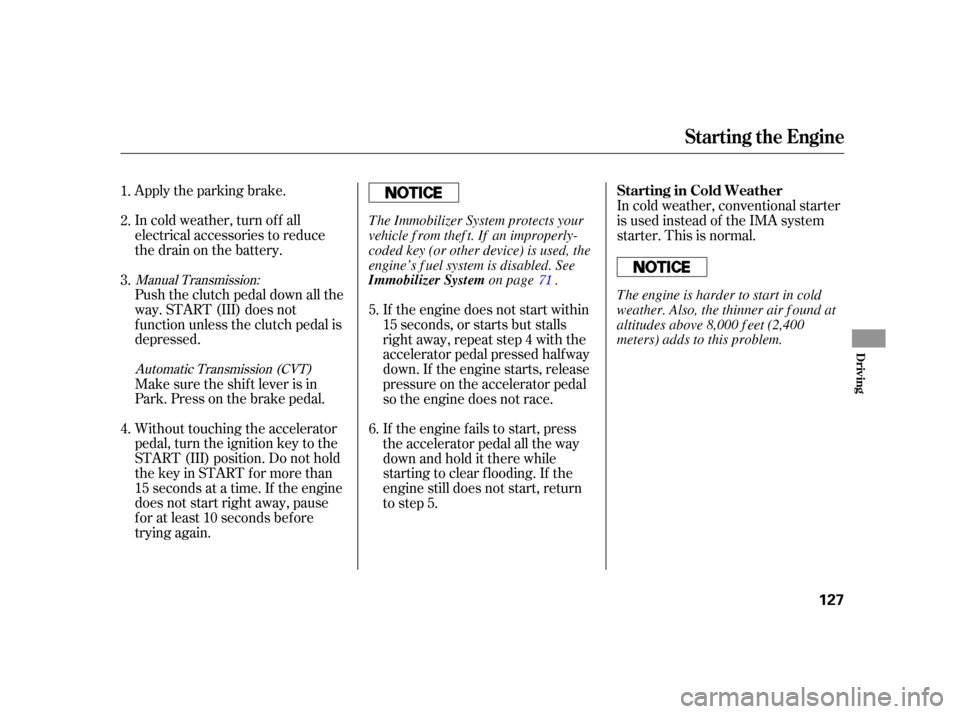
Apply the parking brake.
In cold weather, turn of f all
electrical accessories to reduce
the drain on the battery.
Push the clutch pedal down all the
way. START (III) does not
f unction unless the clutch pedal is
depressed.
Without touching the accelerator
pedal, turn the ignition key to the
START (III) position. Do not hold
the key in START for more than
15 seconds at a time. If the engine
does not start right away, pause
f or at least 10 seconds bef ore
trying again. Make sure the shif t lever is in
Park. Press on the brake pedal.If the engine does not start within
15 seconds, or starts but stalls
right away, repeat step 4 with the
accelerator pedal pressed halfway
down. If the engine starts, release
pressure on the accelerator pedal
so the engine does not race.
If the engine fails to start, press
the accelerator pedal all the way
downandholdittherewhile
starting to clear flooding. If the
engine still does not start, return
to step 5.In cold weather, conventional starter
is used instead of the IMA system
starter. This is normal.
1.
2.
3.
4. 5.
6.
Manual Transmission:
Automatic Transmission (CVT) 71
Starting the Engine
Starting in Cold Weather
Driving
127
Immobilizer System T he Immobilizer System protects your
vehicle f rom thef t. If an improperly-
coded key (or other device) is used, the
engine’s f uel system is disabled. See
on page . The engine is harder to start in cold
weather. Also, the thinner air f ound at
altitudes above 8,000 f eet (2,400
meters) adds to this problem.
Page 130 of 228
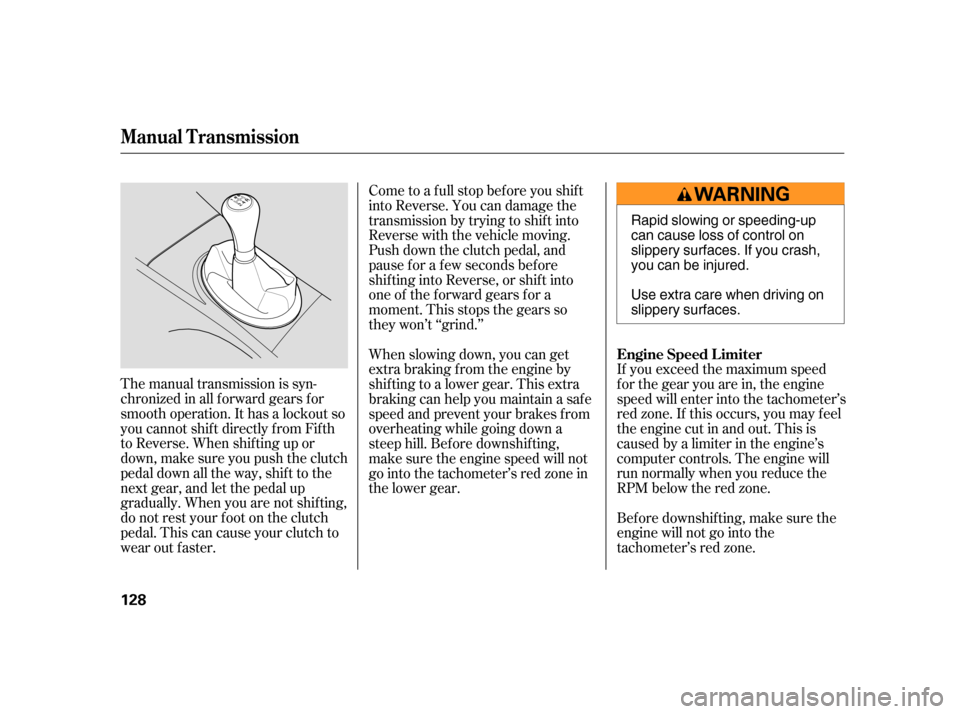
The manual transmission is syn-
chronizedinallforwardgearsfor
smooth operation. It has a lockout so
you cannot shift directly from Fifth
to Reverse. When shif ting up or
down,makesureyoupushtheclutch
pedal down all the way, shift to the
next gear, and let the pedal up
gradually. When you are not shif ting,
do not rest your f oot on the clutch
pedal. This can cause your clutch to
wear out faster.Come to a full stop before you shift
into Reverse. You can damage the
transmission by trying to shift into
Reverse with the vehicle moving.
Push down the clutch pedal, and
pause f or a f ew seconds bef ore
shif ting into Reverse, or shif t into
one of the f orward gears f or a
moment. This stops the gears so
they won’t ‘‘grind.’’
If you exceed the maximum speed
f or the gear you are in, the engine
speed will enter into the tachometer’s
red zone. If this occurs, you may f eel
the engine cut in and out. This is
caused by a limiter in the engine’s
computer controls. The engine will
run normally when you reduce the
RPM below the red zone.
Bef ore downshif ting, make sure the
engine will not go into the
tachometer’s red zone.
When slowing down, you can get
extra braking f rom the engine by
shifting to a lower gear. This extra
braking can help you maintain a safe
speed and prevent your brakes f rom
overheating while going down a
steep hill. Bef ore downshif ting,
make sure the engine speed will not
go into the tachometer’s red zone in
the lower gear.
Engine Speed L imiter
Manual T ransmission
128
Rapid slowing or speeding-up
can cause loss of control on
slippery surfaces. If you crash,
you can be injured.
Use extra care when driving on
slippery surfaces.
Page 131 of 228

To maximize f uel economy, your
Civic Hybrid has an Auto Idle Stop
f unction. Under certain conditions,
the engine will shut of f when you
come to a stop. Those conditions are:The engine coolant is nearly up to
normal operating temperature.
The vehicle’s speed is below 19
mph (30 km/h) and you are
pressing on the brake pedal to
come to a stop.
You depress the clutch pedal.
You are not pressing on the
accelerator pedal.
The IMA battery is charged
enough to operate the system. The Auto Idle Stop f unction may not
activate if the IMA battery
temperature is too hot or too cold. During Auto Idle Stop, the IMA
charge and power brake vacuum
reserve is monitored by the system.
If either drops below a desired level,
and the shif t lever is in Neutral, the
engine will restart so it can recharge
the IMA battery or replenish the
vacuum supply.
The ECON mode is selected, and
the outside temperature is above
f reezing, or the f an speed control
dial is off (see page ).
There is adequate vacuum reserve
f or the power brakes.
When these conditions are met, the
engine will shut of f as you come to a
stop. It will start again automatically
when you depress the clutch pedal
f ully and move the shif t lever to f irst
gear. There is no need to start the
engine with the ignition switch.
It is recommended that you move
the shift lever to Neutral and remove
your f oot f rom the clutch pedal while
you are stopped. Sitting with the
clutch pedal depressed and the shif t
lever in gear will cause the engine to
continue running, def eating the f uel
economy benef its of the Auto Idle
Stop f unction. 87
Auto Idle Stop
Manual T ransmission
Driving
129
Page 132 of 228
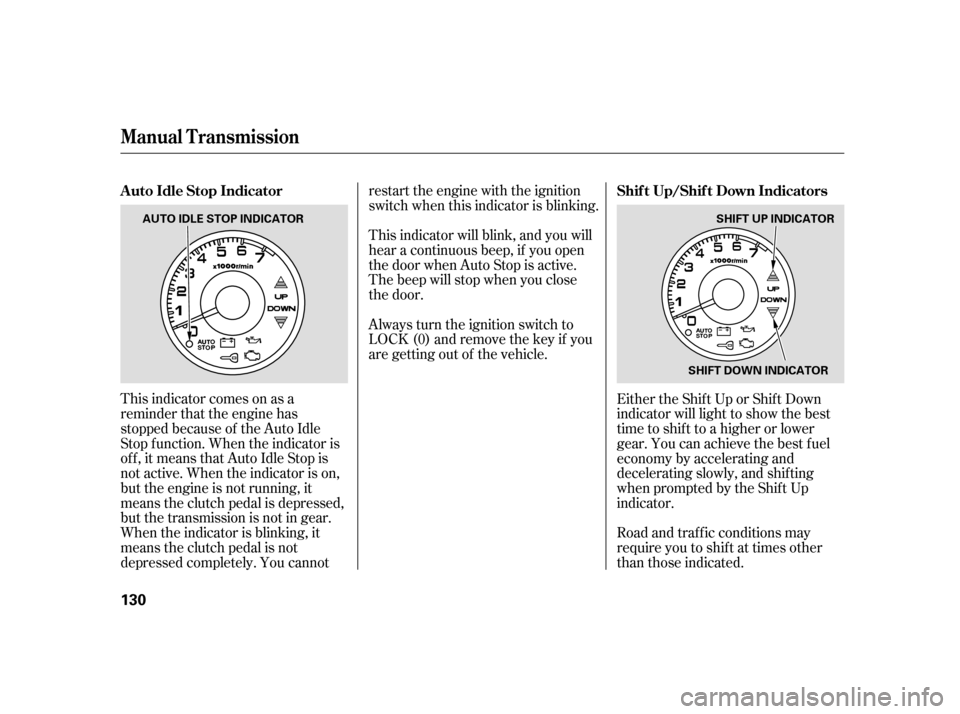
This indicator will blink, and you will
hear a continuous beep, if you open
the door when Auto Stop is active.
The beep will stop when you close
the door.
Always turn the ignition switch to
LOCK (0) and remove the key if you
are getting out of the vehicle.
This indicator comes on as a
reminder that the engine has
stopped because of the Auto Idle
Stop f unction. When the indicator is
of f , it means that Auto Idle Stop is
not active. When the indicator is on,
but the engine is not running, it
means the clutch pedal is depressed,
but the transmission is not in gear.
When the indicator is blinking, it
means the clutch pedal is not
depressed completely. You cannot restart the engine with the ignition
switch when this indicator is blinking.
Either the Shift Up or Shift Down
indicator will light to show the best
time to shift to a higher or lower
gear. You can achieve the best f uel
economy by accelerating and
decelerating slowly, and shif ting
when prompted by the Shif t Up
indicator.
Road and traffic conditions may
require you to shif t at times other
than those indicated.
A uto Idle Stop Indicator
Shif t Up/Shif t Down Indicators
Manual T ransmission
130
AUTO IDLE STOP INDICATOR SHIFT UP INDICATOR
SHIFT DOWN INDICATOR
Page 143 of 228
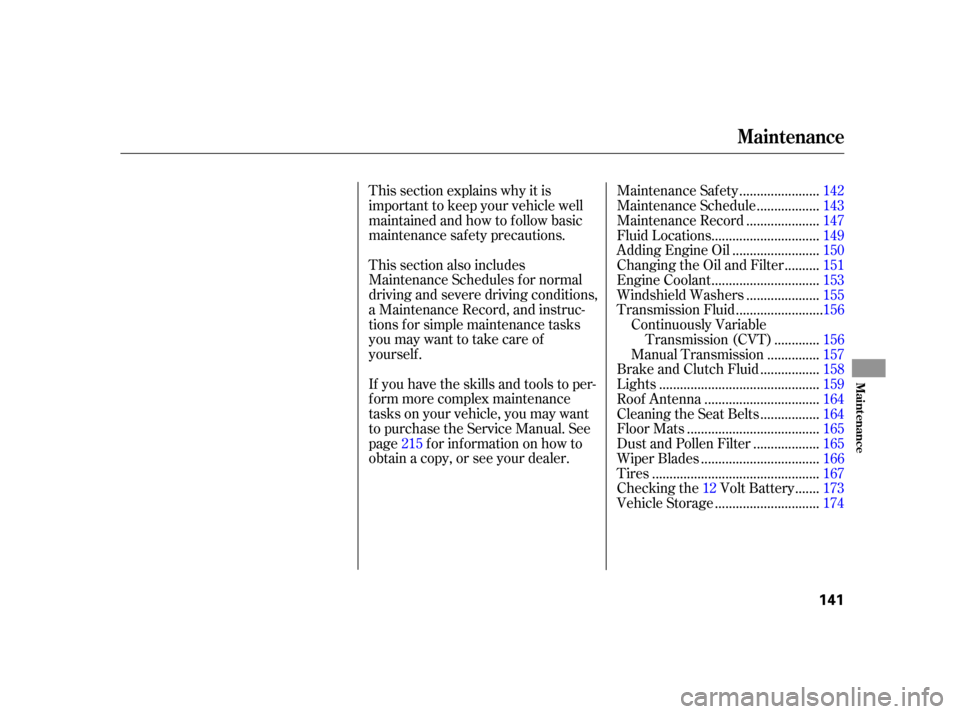
This section also includes
Maintenance Schedules f or normal
driving and severe driving conditions,
a Maintenance Record, and instruc-
tions f or simple maintenance tasks
you may want to take care of
yourself .
If you have the skills and tools to per-
f orm more complex maintenance
tasks on your vehicle, you may want
to purchase the Service Manual. See
page f or inf ormation on how to
obtain a copy, or see your dealer. This section explains why it is
important to keep your vehicle well
maintained and how to f ollow basic
maintenance saf ety precautions.......................
Maintenance Saf ety .142
.................
Maintenance Schedule . 143
....................
Maintenance Record .147
..............................
Fluid Locations .149
........................
Adding Engine Oil .150
.........
Changing the Oil and Filter . 151
..............................
Engine Coolant .153
....................
Windshield Washers .155
........................
Transmission Fluid .156
Continuously Variable ............
Transmission (CVT) . 156
..............
Manual Transmission . 157
................
Brake and Clutch Fluid . 158
.............................................
Lights .159
................................
Roof Antenna .164
................
Cleaning the Seat Belts . 164
.....................................
Floor Mats .165
..................
DustandPollenFilter . 165
.................................
Wiper Blades .166
...............................................
Tires .167
......
Checking the 12Volt Battery . 173
.............................
Vehicle Storage .174
215
Maintenance
Maint enance
141
Page 151 of 228
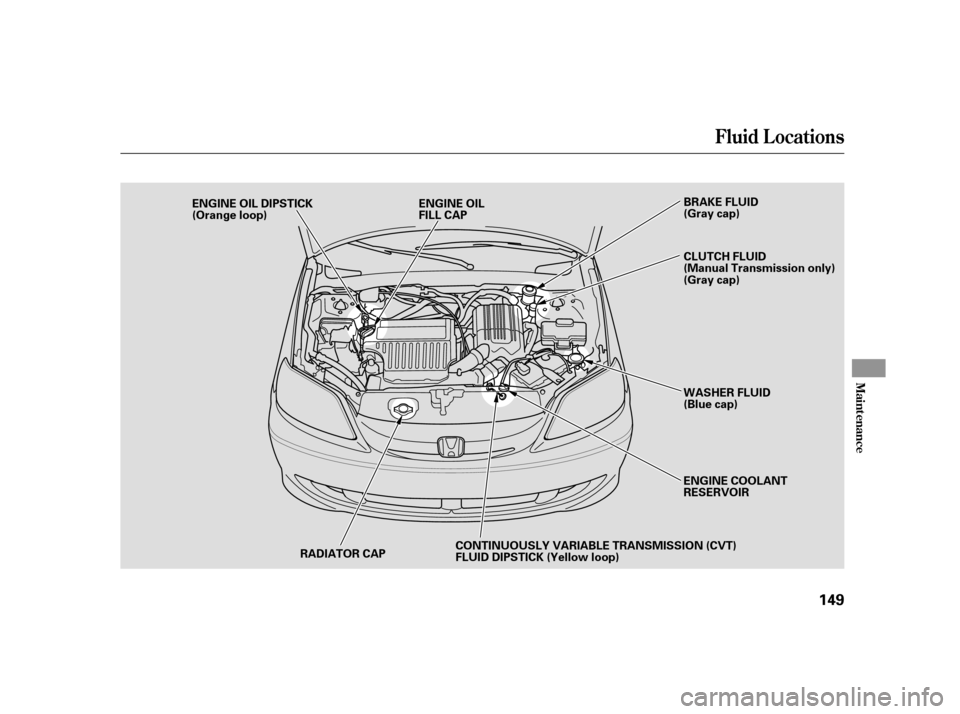
Fluid Locations
Maint enance
149
RADIATOR CAP
ENGINE OIL DIPSTICK
(Orange loop)
ENGINE OIL
FILL CAP
CONTINUOUSLY VARIABLE TRANSMISSION (CVT)
FLUID DIPSTICK (Yellow loop) BRAKE FLUID
(Gray cap)
WASHER FLUID
(Blue cap)
ENGINE COOLANT
RESERVOIR CLUTCH FLUID
(Manual Transmission only)
(Gray cap)
Page 160 of 228
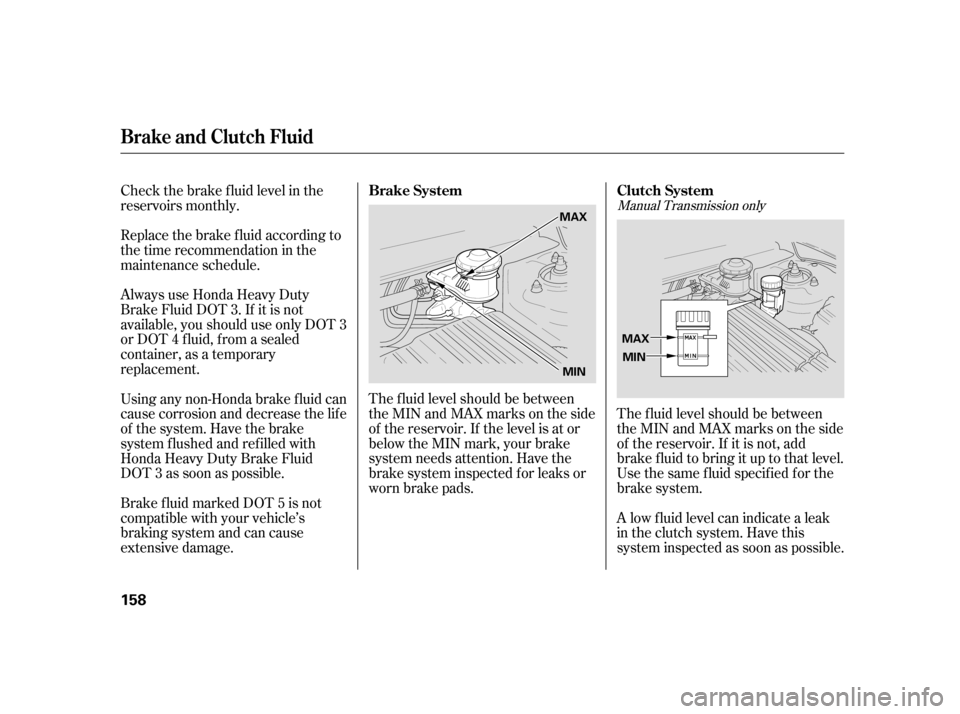
Check the brake f luid level in the
reservoirs monthly.
Always use Honda Heavy Duty
Brake Fluid DOT 3. If it is not
available, you should use only DOT 3
or DOT 4 f luid, f rom a sealed
container, as a temporary
replacement.The f luid level should be between
theMINandMAXmarksontheside
of the reservoir. If the level is at or
below the MIN mark, your brake
system needs attention. Have the
brake system inspected f or leaks or
worn brake pads.The f luid level should be between
theMINandMAXmarksontheside
of the reservoir. If it is not, add
brake f luid to bring it up to that level.
Use the same fluid specified for the
brake system.
Replace the brake f luid according to
the time recommendation in the
maintenance schedule.
Using any non-Honda brake f luid can
cause corrosion and decrease the lif e
of the system. Have the brake
system f lushed and ref illed with
Honda Heavy Duty Brake Fluid
DOT 3 as soon as possible.
Brake f luid marked DOT 5 is not
compatible with your vehicle’s
braking system and can cause
extensive damage.
A low f luid level can indicate a leak
in the clutch system. Have this
system inspected as soon as possible.
Manual Transmission only
Brake System
Clutch System
Brake and Clutch Fluid
158
MAX
MIN MAX
MIN
Page 184 of 228

You hear nothing, or almost
nothing. The engine’s starter
motor does not operate at all, or
operates very slowly.
You can hear the starter motor
operating normally, or the starter
motor sounds like it is spinning
f aster than normal, but the engine
does not start up and run.When you turn the ignition switch to
START (III), you do not hear the
normal noise of the engine trying to
start. You may hear a clicking sound
or series of clicks, or nothing at all.
Check the transmission interlock.
If you have a manual transmission,
the clutch pedal must be pushed
all the way to the f loor or the
starter will not operate. With an
automatic transmission, it must be
in Park or Neutral. Turn the ignition switch to START
(III). If the headlights do not dim,
check the condition of the f uses. If
thefusesareOK,thereis
probably something wrong with
the electrical circuit f or the
ignition switch or starter motor.
You will need a qualif ied
technician to determine the
problem (see
on page ).
Check these things:
Diagnosing why the engine won’t
start f alls into two areas, depending
on what you hear when you turn the
key to START (III):
Turn the ignition switch to ON (II).
Turn on the headlights, and check
their brightness. If the headlights
areverydimordonotcomeonat
all, the battery is discharged. Seeon page . If the headlights dim noticeably or
go out when you try to start the
engine, either the battery is
discharged or the connections are
corroded. Check the condition of
the 12 volt battery and terminal
connections (see page ). You
canthentryjumpstartingthe
vehicle from a booster battery
(see page ).
184 197
173
184
If theEngineWon’tStart
Nothing Happens or the Starter
Motor Operates Very Slowly
Emergency T owing
Jump Starting
182